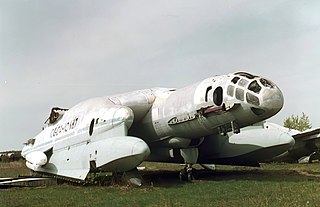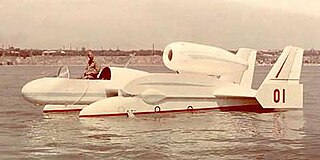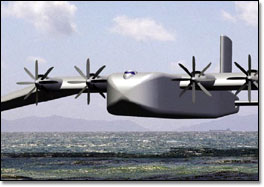 W
WThe following is a list of WIG or 'wing-in-ground'-effect craft, also referred to as water-skimming wingships or, in Russia, 'ekranoplans'.
 W
WThe A-90 Orlyonok is a Soviet ekranoplan that was designed by Rostislav Evgenievich Alexeyev of the Central Hydrofoil Design Bureau.
 W
WThe Aerocon Dash-1.6 wingship was a proposed American ground-effect vehicle intended to carry large cargos and thousands of passengers over long distances at near-aircraft speeds.
 W
WThe Bartini Beriev VVA-14 Vertikaľno-Vzletayushchaya Amfibiya was a wing-in-ground-effect aircraft developed in the Soviet Union during the early 1970s. Designed to be able to take off from the water and fly at high speed over long distances, it was to make true flights at high altitude, but also have the capability of flying efficiently just above the sea surface, using aerodynamic ground effect. The VVA-14 was designed by Italian-born designer Robert Bartini in answer to a perceived requirement to destroy United States Navy Polaris missile submarines. The final aircraft was retired in 1987.
 W
WThe HESA Bavar 2 is a ground effect vehicle unveiled in September 2010 by the IRGC Navy. It is designed to have a small radar signature, and therefore be difficult to track on radar, to be able to remain undetected while carrying out patrol missions. The vehicle can be equipped with different kinds of weapons including locally produced rockets and missiles. The design is based on the work of Alexander Lippisch and is similar in concept to the 1970s experimental RFB X-113.
 W
WThe Beriev Be-1 was an experimental wing-in-ground-effect aircraft developed in the Soviet Union during the 1960s.
 W
WThe Beriev Be-2500 Neptun is a super heavy amphibious transport aircraft that, as of 2007, was in design and development by Russian design firm Beriev. The maximum takeoff weight is estimated at 2500 tons, hence its name.
 W
WThe Boeing Pelican ULTRA was a proposed ground effect fixed-wing aircraft under study by Boeing Phantom Works.
 W
WThe KM, known colloquially as the Caspian Sea Monster, was an experimental ground effect vehicle developed in the Soviet Union in the 1960s by the Central Hydrofoil Design Bureau. The KM began operation in 1966, and was continuously tested by the Soviet Navy until 1980 when it crashed into the Caspian Sea.
 W
WA ground-effect vehicle (GEV), also called a wing-in-ground-effect (WIG), ground-effect craft, wingship, flarecraft or ekranoplan, is a vehicle that is able to move over the surface by gaining support from the reactions of the air against the surface of the earth or water. Typically, it is designed to "fly" over a level surface by making use of ground effect, the aerodynamic interaction between the moving wing and the surface below. Some models can operate over any flat area such as frozen lakes or flat plains similar to a hovercraft.
 W
WThe Lun-class ekranoplan is a ground effect vehicle (GEV) designed by Rostislav Evgenievich Alexeyev in 1975 and used by the Soviet and Russian navies from 1987 until sometime in the late 1990s.
 W
WSpasatel is an ekranoplan project, originally planned by the Soviet Ministry of Defense, which at the time was classified as "Top Secret". Originally the vehicle was intended to serve as the missile carrier of the project Lun, but was then converted into an ambulance, but never completed. Russia has revived the 600-metric-ton-maximum-takeoff-weight ground-effect vehicle to be used for search and rescue operations in the Arctic and Pacific, as well as cargo and troop delivery to remote military bases.